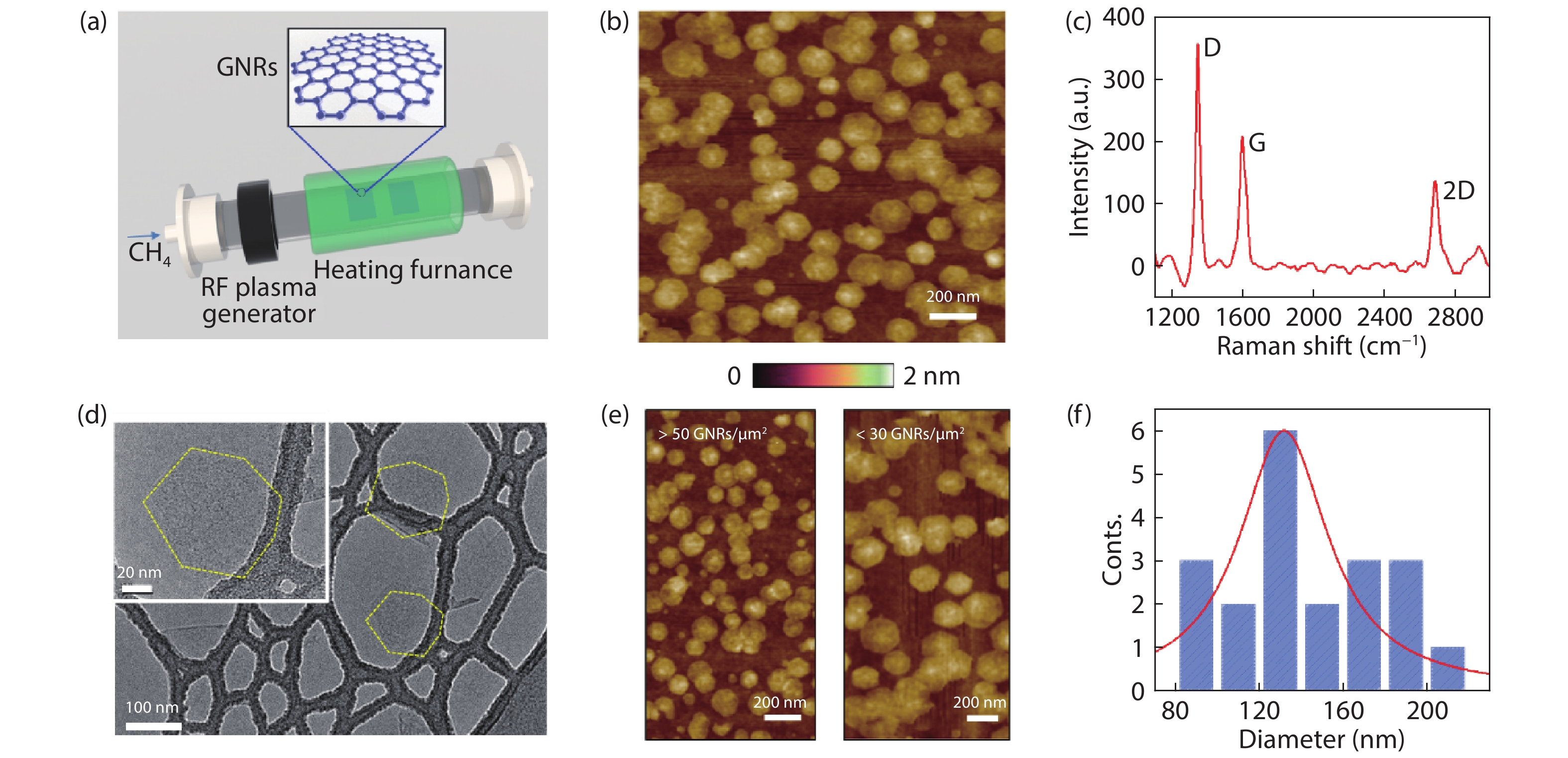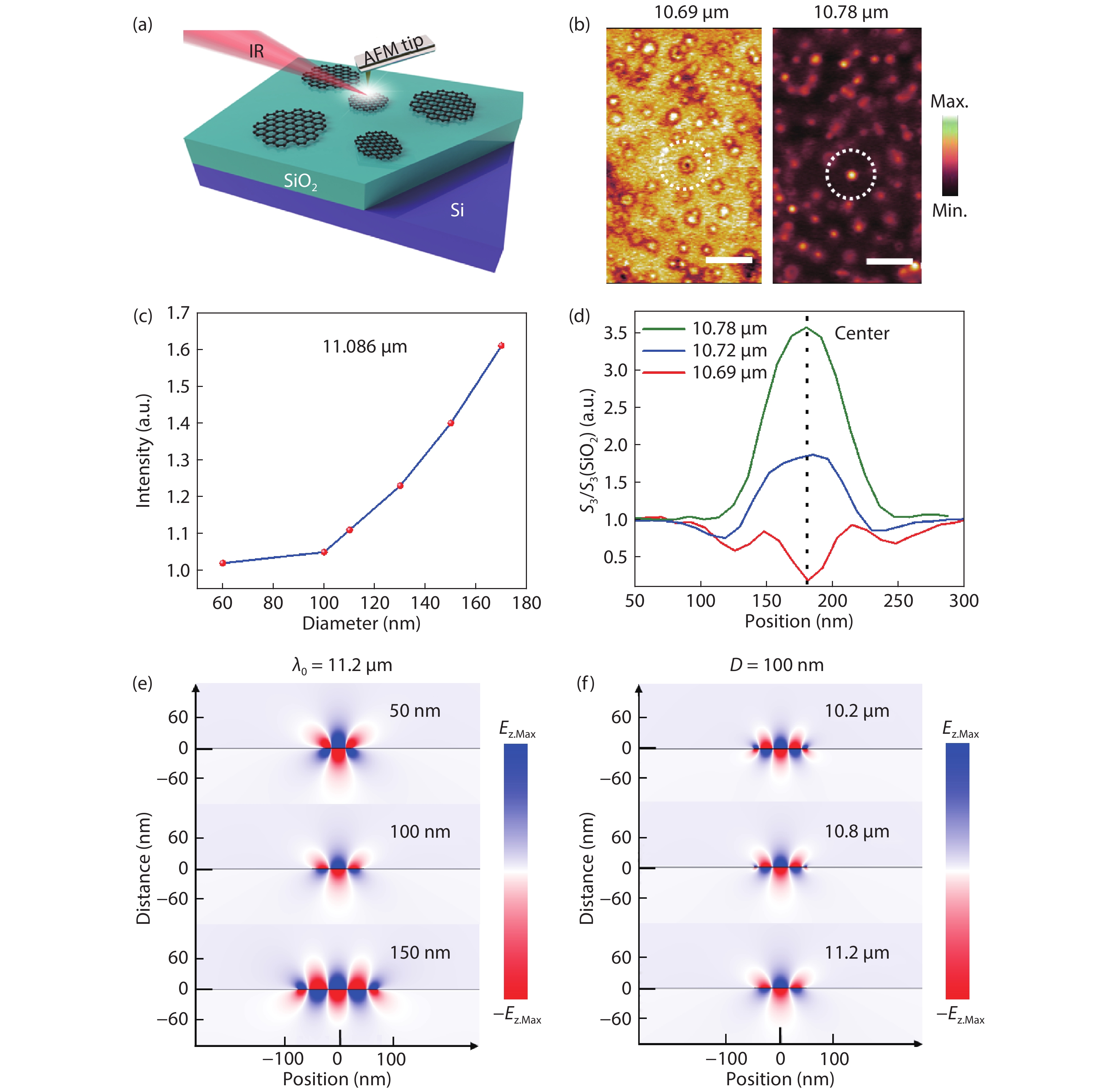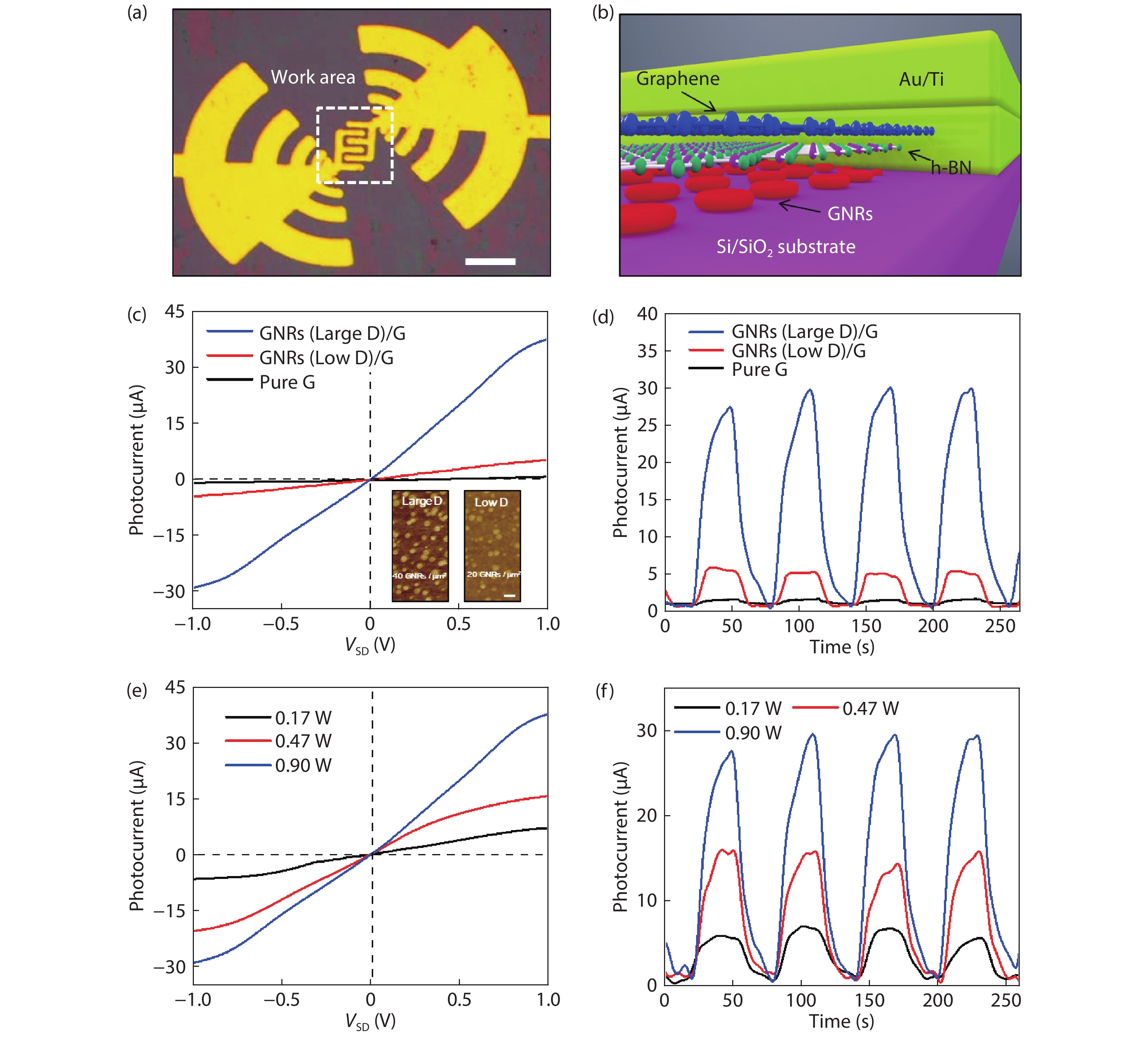| Citation: |
Tian Sun, Weiliang Ma, Donghua Liu, Xiaozhi Bao, Babar Shabbir, Jian Yuan, Shaojuan Li, Dacheng Wei, Qiaoliang Bao. Graphene plasmonic nanoresonators/graphene heterostructures for efficient room-temperature infrared photodetection[J]. Journal of Semiconductors, 2020, 41(7): 072907. doi: 10.1088/1674-4926/41/7/072907
****
T Sun, W L Ma, D H Liu, X Z Bao, B Shabbir, J Yuan, S J Li, D C Wei, Q L Bao, Graphene plasmonic nanoresonators/graphene heterostructures for efficient room-temperature infrared photodetection[J]. J. Semicond., 2020, 41(7): 072907. doi: 10.1088/1674-4926/41/7/072907.
|
Graphene plasmonic nanoresonators/graphene heterostructures for efficient room-temperature infrared photodetection
DOI: 10.1088/1674-4926/41/7/072907
More Information
-
Abstract
High-performance infrared (IR) photodetectors made by low dimensional materials promise a wide range of applications in communication, security and biomedicine. Moreover, light-harvesting effects based on novel plasmonic materials and their combinations with two-dimensional (2D) materials have raised tremendous interest in recent years, as they may potentially help the device complement or surpass currently commercialized IR photodetectors. Graphene is a particularly attractive plasmonic material because graphene plasmons are electrically tunable with a high degree of electromagnetic confinement in the mid-infrared (mid-IR) to terahertz regime and the field concentration can be further enhanced by forming nanostructures. Here, we report an efficient mid-IR room-temperature photodetector enhanced by plasmonic effect in graphene nanoresonators (GNRs)/graphene heterostructure. The plasmon polaritons in GNRs are size-dependent with strong field localization. Considering that the size and density of GNRs are controllable by chemical vapor deposition method, our work opens a cost-effective and scalable pathway to fabricate efficient IR optoelectronic devices with wavelength tunability.-
Keywords:
- graphene plasmons,
- nanoresonators,
- s-SNOM,
- mid-infrared photodetectors
-
References
[1] Schneider H, Fuchs F, Dischler B, et al. Intersubband absorption and infrared photodetection at 3.5 and 4.2 μm in GaAs quantum wells. Appl Phys Lett, 1991, 58, 2234 doi: 10.1063/1.104936[2] Naumann A, Navarro-González M, Peddireddi S, et al. Fourier transform infrared microscopy and imaging: Detection of fungi in wood. Fungal Genet Biol, 2005, 42, 829 doi: 10.1016/j.fgb.2005.06.003[3] Lao Y F, Unil Perera A G, Li L H, et al. Tunable hot-carrier photodetection beyond the bandgap spectral limit. Nat Photonics, 2014, 8, 412 doi: 10.1038/nphoton.2014.80[4] Chen X L, Lu X B, Deng B C, et al. Widely tunable black phosphorus mid-infrared photodetector. Nat Commun, 2017, 8, 1672 doi: 10.1038/s41467-017-01978-3[5] Freitag M, Low T, Zhu W J, et al. Photocurrent in graphene harnessed by tunable intrinsic plasmons. Nat Commun, 2013, 4, 1951 doi: 10.1038/ncomms2951[6] Amani M, Regan E, Bullock J, et al. Mid-wave infrared photoconductors based on black phosphorus-arsenic alloys. ACS Nano, 2017, 11, 11724 doi: 10.1021/acsnano.7b07028[7] Lin Y M, Dimitrakopoulos C, Jenkins K A, et al. 100-GHz transistors from wafer-scale epitaxial graphene. Science, 2010, 327, 662 doi: 10.1126/science.1184289[8] Bao Q L, Loh K P. Graphene photonics, plasmonics, and broadband optoelectronic devices. ACS Nano, 2012, 6, 3677 doi: 10.1021/nn300989g[9] Vicarelli L, Vitiello M S, Coquillat D, et al. Graphene field-effect transistors as room-temperature terahertz detectors. Nat Mater, 2012, 11, 865 doi: 10.1038/nmat3417[10] Sensale-Rodriguez B, Yan R S, Kelly M M, et al. Broadband graphene terahertz modulators enabled by intraband transitions. Nat Commun, 2012, 3, 780 doi: 10.1038/ncomms1787[11] Mueller T, Xia F N, Avouris P. Graphene photodetectors for high-speed optical communications. Nat Photonics, 2010, 4, 297 doi: 10.1038/nphoton.2010.40[12] Lopez-Sanchez O, Lembke D, Kayci M, et al. Ultrasensitive photodetectors based on monolayer MoS2. Nat Nanotechnol, 2013, 8, 497 doi: 10.1038/nnano.2013.100[13] Wang X D, Wang P, Wang J L, et al. Ultrasensitive and broadband MoS2 photodetector driven by ferroelectrics. Adv Mater, 2015, 27, 6575 doi: 10.1002/adma.201503340[14] Long M S, Wang P, Fang H H, et al. Progress, challenges, and opportunities for 2D material based photodetectors. Adv Funct Mater, 2019, 29, 1803807 doi: 10.1002/adfm.201803807[15] Rao G, Freitag M, Chiu H Y, et al. Raman and photocurrent imaging of electrical stress-induced p–n junctions in graphene. ACS Nano, 2011, 5, 5848 doi: 10.1021/nn201611r[16] Freitag M, Low T, Xia F N, et al. Photoconductivity of biased graphene. Nat Photonics, 2013, 7, 53 doi: 10.1038/nphoton.2012.314[17] Buscema M, Island J O, Groenendijk D J, et al. Photocurrent generation with two-dimensional van der Waals semiconductors. Chem Soc Rev, 2015, 44, 3691 doi: 10.1039/C5CS00106D[18] Zhou X, Hu X Z, Yu J, et al. 2D layered material-based van der Waals heterostructures for optoelectronics. Adv Funct Mater, 2018, 28, 1706587 doi: 10.1002/adfm.201706587[19] Huo N J, Konstantatos G. Recent progress and future prospects of 2D-based photodetectors. Adv Mater, 2018, 30, 1801164 doi: 10.1002/adma.201801164[20] Knight M W, Sobhani H, Nordlander P, et al. Photodetection with active optical antennas. Science, 2011, 332, 702 doi: 10.1126/science.1203056[21] Fang Z Y, Liu Z, Wang Y M, et al. Graphene-antenna sandwich photodetector. Nano Lett, 2012, 12, 3808 doi: 10.1021/nl301774e[22] Ju L, Geng B S, Horng J, et al. Graphene plasmonics for tunable terahertz metamaterials. Nat Nanotechnol, 2011, 6, 630 doi: 10.1038/nnano.2011.146[23] Atwater H A, Polman A. Plasmonics for improved photovoltaic devices. Nat Mater, 2010, 9, 205 doi: 10.1038/nmat2629[24] Anker J N, Hall W P, Lyandres O, et al. Biosensing with plasmonic nanosensors. Nat Mater, 2008, 7, 442 doi: 10.1038/nmat2162[25] Hillenbrand R, Taubner T, Keilmann F. Phonon-enhanced light–matter interaction at the nanometre scale. Nature, 2002, 418, 159 doi: 10.1038/nature00899[26] Boltasseva A, Atwater H A. Low-loss plasmonic metamaterials. Science, 2011, 331, 290 doi: 10.1126/science.1198258[27] Novotny L, Hecht B. Principles of nano-optics. Cambridge: Cambridge University Press, 2009[28] Khurgin J B, Boltasseva A. Reflecting upon the losses in plasmonics and metamaterials. MRS Bull, 2012, 37, 768 doi: 10.1557/mrs.2012.173[29] Khurgin J B, Sun G. In search of the elusive lossless metal. Appl Phys Lett, 2010, 96, 181102 doi: 10.1063/1.3425890[30] Chen J N, Badioli M, Alonso-González P, et al. Optical nano-imaging of gate-tunable graphene plasmons. Nature, 2012, 487, 77 doi: 10.1038/nature11254[31] Fei Z, Rodin A S, Andreev G O, et al. Gate-tuning of graphene plasmons revealed by infrared nano-imaging. Nature, 2012, 487, 82 doi: 10.1038/nature11253[32] Ni G X, McLeod A S, Sun Z, et al. Fundamental limits to graphene plasmonics. Nature, 2018, 557, 530 doi: 10.1038/s41586-018-0136-9[33] Fang Z Y, Wang Y M, Schlather A E, et al. Active tunable absorption enhancement with graphene nanodisk arrays. Nano Lett, 2014, 14, 299 doi: 10.1021/nl404042h[34] Yan H G, Low T, Zhu W J, et al. Damping pathways of mid-infrared plasmons in graphene nanostructures. Nat Photonics, 2013, 7, 394 doi: 10.1038/nphoton.2013.57[35] Nikitin A Y, Alonso-González P, Vélez S, et al. Real-space mapping of tailored sheet and edge plasmons in graphene nanoresonators. Nat Photonics, 2016, 10, 239 doi: 10.1038/nphoton.2016.44[36] Yang X X, Zhai F, Hu H, et al. Far-field spectroscopy and near-field optical imaging of coupled plasmon-phonon polaritons in 2D van der waals heterostructures. Adv Mater, 2016, 28, 2931 doi: 10.1002/adma.201505765[37] Xu Q Y, Ma T, Danesh M, et al. Effects of edge on graphene plasmons as revealed by infrared nanoimaging. Light: Sci Appl, 2017, 6, e16204 doi: 10.1038/lsa.2016.204[38] Liu D H, Chen X S, Hu Y B, et al. Raman enhancement on ultra-clean graphene quantum dots produced by quasi-equilibrium plasma-enhanced chemical vapor deposition. Nat Commun, 2018, 9, 193 doi: 10.1038/s41467-017-02627-5[39] Chen X Z, Hu D B, Mescall R, et al. Modern scattering-type scanning near-field optical microscopy for advanced material research. Adv Mater, 2019, 31, 1804774 doi: 10.1002/adma.201804774 -
Proportional views






 DownLoad:
DownLoad:
















